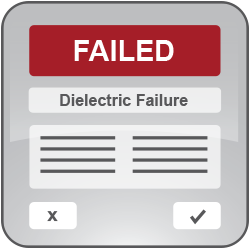Your tester has performed a high voltage test on your cable. The results appear on the screen and unfortunately there was an error. What kind or error is it? Is there a way to repair it?
High voltage testing checks for unintended connections. With this sort of test contaminates, weak insulation, and other problems can be found. High voltage test errors can be complex and confusing if you don’t know what each result means. A basic overview can clear up a lot of the confusion.
A low voltage test will report one of three errors.
- Overcurrent: A larger amount of current is able to flow than the cable expects.
- Had Leakage: More current leaks through the wire than is acceptable.
- Dielectric Failure: A weakness is found in the insulation and the voltage arcs between wires.
If using a Cirris CH2, the names of these errors may be different. Some of these errors can be repaired. For more information on high voltage test errors, see the article in the Cirris Learning Center.

Further Reading:
You Tested a Cable. What Now?
How to be Safe during High Voltage Testing
What is the Difference between High Voltage and Hipot?